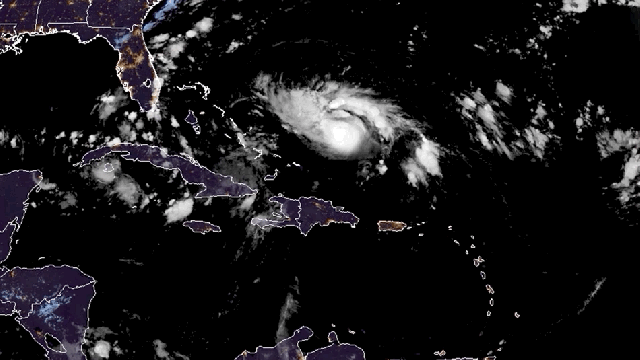Hurricane Dorian grazed Puerto Rico as a tropical storm and has since spent the past two days feeding on warm Atlantic waters. That’s allowed the storm to pick up steam with winds over the past 48 hours, increasing from 80km/h to 177km/h as of Friday morning local time.
The winds will keep build over the weekend as the storm rolls over the Bahamas and are forecast reach 225km/h — which would make Dorian a robust Category 4 — as the storm approaches landfall in the US early next week, likely somewhere on the east coast of Florida.
That raises huge risks for one of the most densely populated stretches on the Eastern Seaboard on a busy holiday weekend, a kind of Jaws setup but with a monster storm instead of a monster shark.
“Nobody’s off the hook,” Jamie Rhome, the head of the National Hurricane Centre’s (NHC) storm surge team, told us. “One is often enticed into this ‘I can wait a little bit longer and the models will shift’ approach. But at this point, the Florida east coast has got to be preparing.”
[referenced url=”https://gizmodo.com.au/2019/02/the-funeral-directors-deployed-to-americas-deadliest-disasters/” thumb=”https://i.kinja-img.com/gawker-media/image/upload/s–Es4CRpai–/c_scale,f_auto,fl_progressive,q_80,w_800/osc69vhz1qpdfrjeplkn.jpg” title=”The Funeral Directors Deployed To America’s Deadliest Disasters” excerpt=”Last November, as wildfires ravaged the town of Paradise, California, Robert Vigil received an urgent call from the Department of Health and Human services (HHS). Local officials were racing to identify the remains of fire victims, and Vigil, who has spent 26 years as a funeral director in Yuma County, Arizona, was needed on the scene.”]
In the case of Dorian, preparation means getting ready for multiple impacts that could start well before landfall and last beyond it owing to a few atmospheric quirks that will let Dorian stick around much longer than anyone would want.
Right now, the storm is riding what Rhome called “steering currents”, that is winds in the atmosphere and areas of high and low pressure that act as guardrails for the storm. They’re currently ushering it to the northwest at a pretty steady clip of 19km/h according to the latest NHC update.
But the steering currents are forecast to break down as Dorian approaches land meaning the storm will slow down. Jason Furtado, a meteorologist at the University of Oklahoma, told us in an email that “will leave Dorian ‘stuck’ somewhere near/over Florida under weak steering flow”.
That gives it more time to push storm surge ashore and lash the coast with strong winds and heavy bands of rain. The storm is forecast to make landfall early on Monday morning local time and then move north over central Florida as a hurricane through at least Wednesday.
While NHC has yet to start issuing storm surge forecasts because Dorian’s exact track could change, the prospect of a high surge is, well, high. The storm’s wind field — a key factor for piling up water and pushing it ashore — is growing, as are wind speeds. A stall off the coast would allow for even more time to drive the storm surge slamming into the coast.
Climate change has caused seas to rise by about 23cm in southern Florida, and Dorian will also be arriving on the King Tides, which adds a several extra centimetres still to any storm surge forecast. But it’s the storm itself that will still most of the heavy lifting.
“I’m not losing sleep over the King Tide, I’m losing sleep over the potential storm surge,” Rhome said.
All this points to a need for residents up and down Florida’s east coast to prepare now. Rhome, who lives in Broward County, said he’s moving through his hurricane plan by stocking up on food and water to last multiple days and batteries in case of power outages.
While a number of NHC forecasters will stay put at the agency’s Miami office to help inform the public, Rhome was adamant people in Florida pay attention to what evacuation zone they’re in and to heed all orders to leave the coast if (or more likely when) evacuation orders come down.
Hurricanes are ranked by wind speed, but storm surge and floodwaters are what kill most people. When evacuation orders come down, that’s generally why they’re being issued.
“If an evacuation order is given for your community, that means conditions could be potentially life threatening,” Rhome said.
Growing concern with #Dorian looking like it is strengthening and head towards #Florida. Substantial growth in population the built-environment exacerbates impacts and increased the odds of disaster. Prime example of Expanding Bull’s Eye Effect.(https://t.co/diGx2djXgb) pic.twitter.com/ThJzWRu4Wz
— Stephen M. Strader (@StephenMStrader) August 28, 2019
On top of the increasingly dire forecast, there are also huge concerns because of the number of people in harms way. Stephen Strader, a geographer at Villanova, has noted what he calls the “expanding bullseye effect” of more people living in harms way.
The number of homes in Florida has increased twentyfold since 1950, with some of the heaviest development on the east coast and central part of the state. Those areas are exactly where Dorian is forecasted to head.
Add in an untold number of people who headed to Florida for the last long weekend of summer and you have the potential for a large number of people who don’t understand hurricane risks or evacuation zones, clogged evacuation routes and more people in need of assistance once the storm passes.
